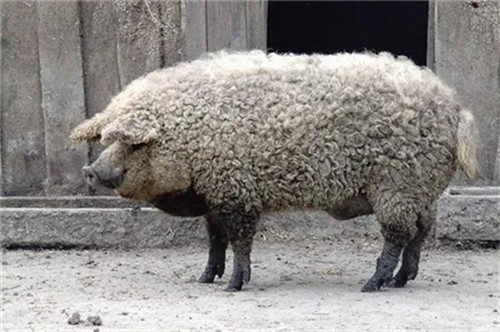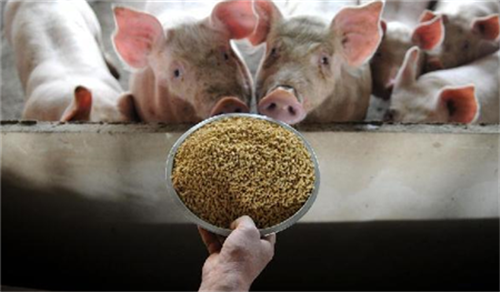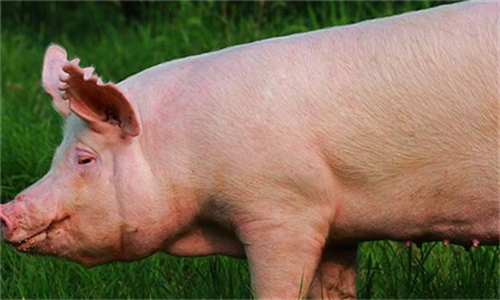The identification and diagnosis of 10 kinds of porcine diarrheal infectious diseases are too complete, hurry up to collect them!
Diarrhea is a common and frequently-occurring disease of pigs. it not only brings direct loss of pig death and a large number of medical expenses to pig farms, but also affects the growth and development of surviving pigs. In recent years, the epidemic of the disease in some areas and pig farms is becoming more and more serious, which has become an important factor restricting the economic benefits of the pig industry. Among various types of diarrhea, the incidence of infectious diseases is the highest and the harm is the most serious. They can be primary or secondary infection, while common medical diseases caused by parasites and improper management and lack of nutrition are often the inducing factors of diarrheal diseases.
1. Red dysentery of piglets
Epidemic characteristics: it mainly affects 1-3-day-old newborn piglets, the course of disease is short, the mortality rate is high, and piglets over 1 week old rarely get sick.
Characteristic symptoms and pathological changes: sudden bloody dysentery or reddish brown loose stool, occasional vomiting, physical weakness, quick death. The characteristic lesions are mainly in the jejunum, the appearance is dark red, the intestinal cavity is full of blood-containing fluid, and the mesenteric lymph nodes are bright red. Sometimes the lesions can extend to the ileum, but there are generally no lesions in the duodenum.
Laboratory test: only the isolation of the pathogen is of little significance, because the bacteria are widespread in the external environment, the key is to make a serum neutralization test to determine the existence of C-type Pleurotus welchii toxin in the intestinal tract of sick pigs.
Prevention and treatment: the disease occurs urgently and dies quickly. It is often too late for treatment or the treatment effect is not good. It mainly depends on the selection of sensitive drugs for prevention.
2. Yellow dysentery of piglets
Epidemic characteristics: mainly occurred within 1 week, especially in 3-day-old piglets, the morbidity and mortality were very high, less in piglets over 7 days old, sows carrying pathogenic Escherichia coli was an important factor in the occurrence of the disease.
Characteristic symptoms and pathological changes: sudden onset, discharge of yellow mucus-like sparse feces or watery feces, mixed with milky patches and air bubbles. There are a large amount of yellow liquid content and gas in the intestine, and the intestinal mucosa shows acute catarrhal inflammation, of which the twelve fat intestine is the most serious, followed by jejunum and ileum, and the colon is lighter.
Laboratory examination: take the contents of the anterior segment of the small intestine for bacterial isolation, culture and identification, and conditional pig farms can be used for the determination of enterotoxin.
Prevention and treatment: comprehensive measures are adopted to improve feeding and management and strengthen health and epidemic prevention. Through the drug sensitivity test, sensitive drugs were selected for prevention and treatment, or microecological preparations were used. Escherichia coli genetic engineering vaccine can also be used to vaccinate sows twice before delivery.
3. White dysentery of piglets
Epidemic characteristics: usually occurred in 10-30-day-old piglets, 10-20 days of age is the most common, can occur all the year round, the morbidity is high, but the fatality rate is low. Poor feeding and management and poor sanitary conditions are the external causes of the disease.
Characteristic symptoms and pathological changes: discharge of gray-white, paste-like sparse feces, fishy smell. There are different amounts of chyme and gas in the intestine, congestion and bleeding in the intestinal mucosa, and thinning of the intestinal wall.
Laboratory examination: Escherichia coli was isolated from small intestine and identified by serological method.
Prevention and treatment: basically the same as yellow dysentery of piglets, but there are more factors affecting the occurrence of the disease. Clinical investigation and analysis should be carried out to find out the inducement and overcome it. Only on this basis can the treatment be effective.
4. Swine dysentery
Epidemic characteristics: it is most common in pigs that are growing and developing after weaning from 2 months to 3 months, with high morbidity and low mortality, and less morbidity in piglets and adults. No seasonality, slow transmission, long epidemic period, easy to relapse, a variety of stress factors can promote the occurrence and prevalence of the disease.
Characteristic symptoms and pathological changes: diarrhea to varying degrees, feces filled with blood and mucus, brown, red or black. Catarrhal hemorrhagic inflammation occurs in the large intestinal mucosa, which develops into fibrinous necrotizing enteritis.
Laboratory examination: the diseased materials were examined directly under dark field or stained under microscope or isolated and cultured, and the spirochetes of porcine dysentery were identified from their morphology, movement characteristics and culture characteristics.
Prevention and treatment: the treatment effect is not good, early treatment is effective, mainly depends on the usual prevention. Sensitive antimicrobials such as dysentery, tetracyclines or quinolones can be selected.

5. Porcine paratyphoid
Epidemic characteristics: mainly affected 2-4-month-old piglets, especially soon after weaning piglets are the most susceptible, adult pigs and suckling piglets rarely disease, no obvious seasonality, sporadic and local epidemic.
Characteristic symptoms and pathological changes: acute type constipation followed by diarrhea, stench of feces, cyanosis of the skin of ears, abdomen and limbs; chronic type is the most common, repeated dysentery, faeces are atherosclerotic or watery, yellowish brown, grayish green or dark brown, stench, eczema-like papules appear in the chest and abdomen in some cases. Autopsy showed that the acute type was mainly septicemia, while the chronic type was mainly cecum and colon with sunken irregular ulcers and pseudomembrane, and gray-white necrotic foci with needle tips to millet size in liver, lymph nodes and lungs.
Laboratory examination: collection of liver, spleen and other diseased materials for bacterial isolation and identification, also known as immunofluorescence test.
Prevention and treatment: attention should be paid to the implementation of comprehensive veterinary health measures. For prevention, piglets can be vaccinated with paratyphoid vaccine or sensitive drugs can be added at multiple age stages. in addition to sensitive drugs, symptomatic treatment should also be used for chronic cases with a long course of disease and weak physique. Such as rehydration (oral rehydration salt) detoxification (0.5% sodium bicarbonate injection), cardiotonic (sodium caffeine, calcium chloride injection), convergence (charcoal powder, tannic acid protein), Zhuangbu (glucose injection, vitamin C) and so on.
6. Rotavirus infection
Epidemic characteristics: it occurred frequently in late autumn, winter and early spring cold seasons, and often mixed with white dysentery of piglets, which mostly occurred in piglets under 8 weeks of age, especially in piglets aged from 10 days to 28 days, with low mortality and recessive infection in adult pigs.
Characteristic symptoms and pathological changes: anorexia, vomiting, dysentery, yellow, gray or black feces, watery or paste. The lesions are mainly limited to the digestive tract, the gastric wall is slow, the stomach is full of milk clots and milk, the intestinal wall becomes thinner, and the contents are grayish yellow or grayish black liquid.
Laboratory examination: rotavirus can be detected by fluorescent antibody or immune electron microscope.
Prevention and treatment: there is no specific treatment, but symptomatic treatment. Prevention mainly depends on strengthening feeding and management, conscientiously implementing general veterinary epidemic prevention measures, and enhancing the resistance of sows and piglets. In epidemic areas, newborn piglets should eat enough colostrum as soon as possible, receive maternal antibody protection, and reduce and alleviate the disease.
7. Transmissible gastroenteritis
Epidemic characteristics: it is more popular in the cold season of winter and spring, pigs of all ages are susceptible, the morbidity and mortality of piglets within 10 days of age are very high, sick pigs over 5 weeks old rarely die, and larger or adult pigs almost do not die.
Characteristic symptoms and pathological changes: sudden vomiting, watery diarrhea, dehydration of piglets, mild symptoms of adult pigs, only anorexia and short-term diarrhea. The stomach of piglets was filled with milk clots, the gastric fundus mucosa was slightly congested, the small intestine was congested, there were foamy liquid and undigested milk clots, and the intestinal wall became thinner and translucent.
Laboratory tests: immunofluorescence antibody test, piglet inoculation test, serum antibody monitoring and other methods can be used in this disease.
Prevention and treatment: there is no specific therapy, antimicrobials can be used to prevent secondary or concurrent infection, and symptomatic treatments such as convergence, antidiarrhoea, cardiotonic, rehydration and strengthening can be used. The attenuated vaccine can be used to vaccinate the whole pig before the epidemic season, or the inactivated vaccine can be used to immunize sows so that piglets can get passive immunity from milk.
8. Epidemic diarrhea
Epidemic features: mostly occur in the cold season, big pigs almost simultaneously develop diarrhea, big pigs can recover within a few days, some piglets die.
Characteristic symptoms and pathological changes: vomiting, watery diarrhea, obvious dehydration, loss of appetite, very similar to porcine transmissible gastroenteritis. The lesion is limited to the small intestine, intestinal dilatation, containing a large amount of yellow fluid, thinning of the intestinal wall and edema of mesenteric lymph nodes.
Laboratory test: porcine epidemic diarrhea virus antigen or virus can be detected by fluorescent antibody or immunoelectron microscope of porcine epidemic diarrhea virus.
Prevention and treatment: at present, there is no specific therapy, attenuated or inactivated vaccine of porcine epidemic diarrhea can be used for preventive injection, and its general treatment is the same as porcine transmissible gastroenteritis.
9. Coccidiosis
Epidemic features: most of them occur in the warm and humid season, and piglets aged from 7 days to 21 days are the most susceptible. In particular, the incidence of piglets raised in dark, moist and unhygienic piglets is higher.
Characteristic symptoms and pathological changes: discharge of soil gray, yellow jelly or watery stool, mixed with a large amount of mucus and undigested feed. Jejunum and ileum showed catarrhal inflammation, intestinal wall thickening, and mucinous exudates attached or necrotic lesions.
Laboratory examination: the oocysts in feces were examined by saturated saline floating collection method.
Prevention and treatment: to create a good sanitary environment and prevent sows from excreting oocysts is the key to the prevention and treatment of the disease. Sulfonamides or aminoproline can be used for treatment.
10. Iron deficiency anemia
Epidemic characteristics: no obvious seasonality, mostly occurred in pig farms with wooden or cement floor without iron supplement measures, and piglets aged from 15 days to 30 days often occurred in large numbers.
Characteristic symptoms and pathological changes: loss of appetite, weight loss, pale mucosa as white as porcelain, light ear shell is gray-white, almost no obvious blood vessels, dysentery and constipation alternately. Autopsy showed that the skin and mucosa were significantly pale, sometimes slightly yellow staining, pleural and peritoneal effusion. Steatosis of parenchyma organs, thin blood, light muscle color, inflammatory lesions of stomach, intestines and lungs.
Laboratory tests: blood tests, hemoglobin and red blood cell count decreased.
Prevention and treatment: iron supplements can be taken orally or injected, such as hemin, iron-cobalt mixture, iron dextran and so on. The preventive effect of iron supplementation for 3-day-old piglets is reliable.
- Prev

In the treatment of pig disease, we must remember that reverse thinking can cure the disease.
In the treatment of pig disease, we must remember that reverse thinking can cure the disease.
- Next

What are the causes of parasitic diseases that cause vomiting in pigs? How to prevent and control?
What are the causes of parasitic diseases that cause vomiting in pigs? How to prevent and control?
Related
- On the eggshell is a badge full of pride. British Poultry Egg Market and Consumer observation
- British study: 72% of Britons are willing to buy native eggs raised by insects
- Guidelines for friendly egg production revised the increase of space in chicken sheds can not be forced to change feathers and lay eggs.
- Risk of delay in customs clearance Australia suspends lobster exports to China
- Pig semen-the Vector of virus Transmission (4)
- Pig semen-the Vector of virus Transmission (3)
- Five common causes of difficult control of classical swine fever in clinic and their countermeasures
- Foot-and-mouth disease is the most effective way to prevent it!
- PED is the number one killer of piglets and has to be guarded against in autumn and winter.
- What is "yellow fat pig"? Have you ever heard the pig collector talk about "yellow fat pig"?

